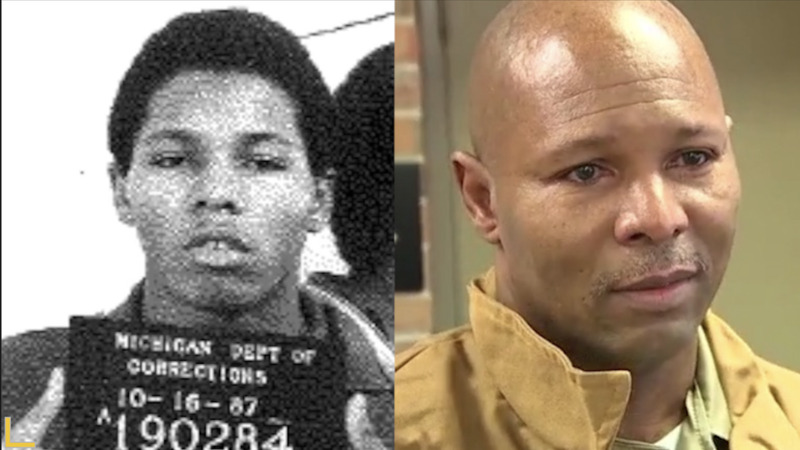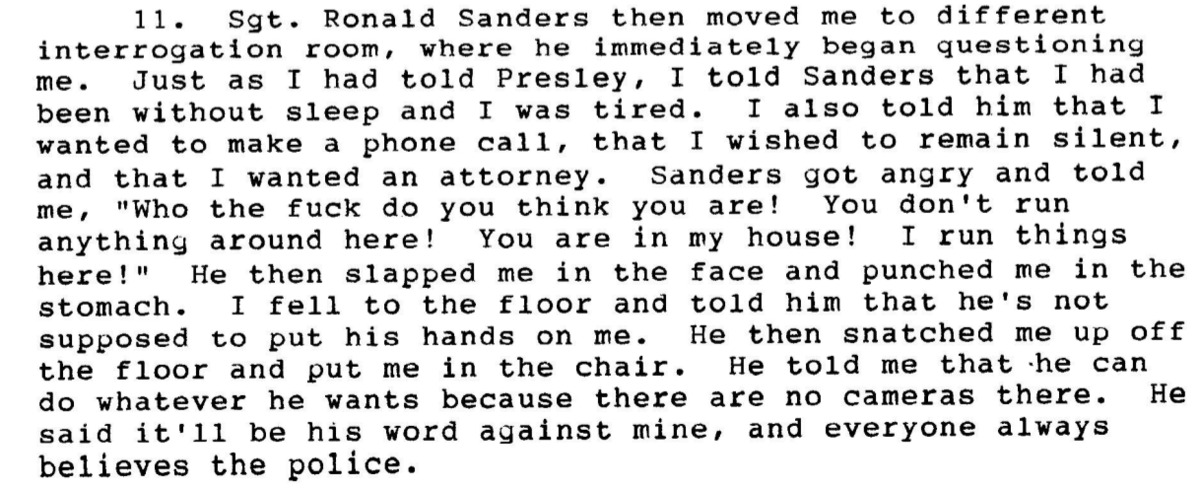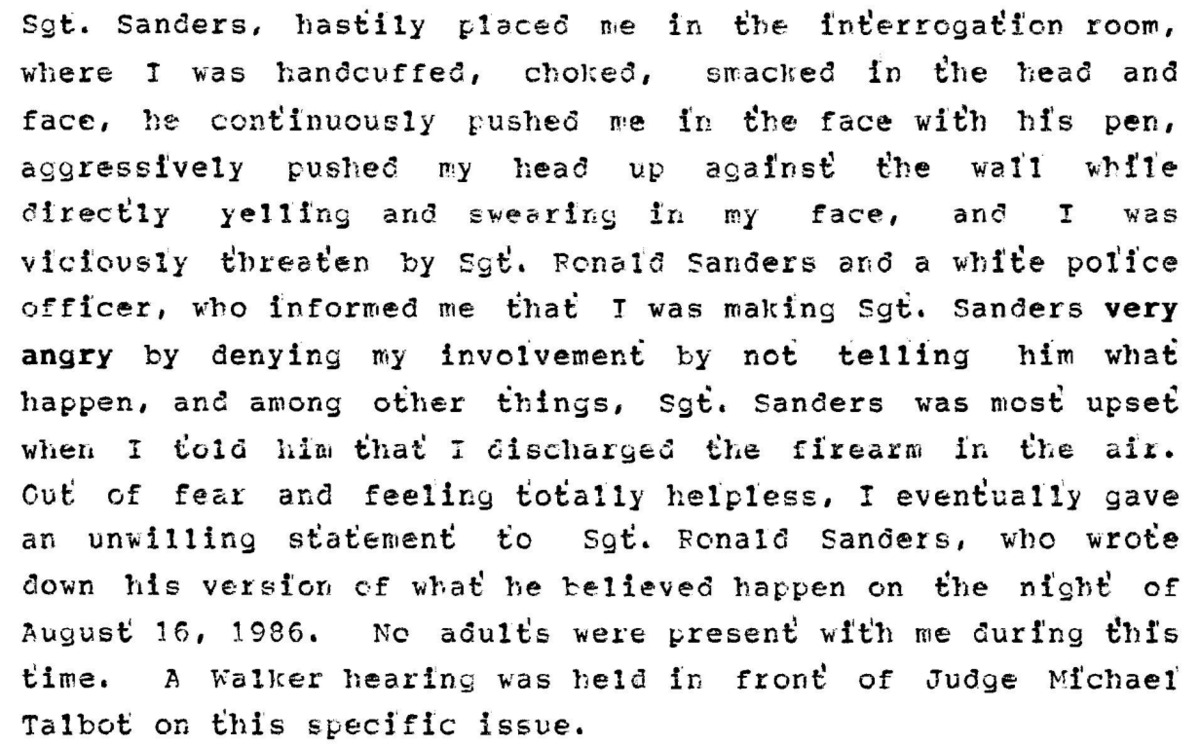Interrogation: Torture and False Convictions
In addition to incidents of police misconduct in the form of street-level enforcement and raids, misconduct also took place within the interrogation rooms and holding cells of precinct buildings and police headquarters. This took shape through officers holding suspects longer than necessary, “drag-net” style roundups in search of possible suspects, verbal threats and intimidation, as well as physical abuse. In many cases, post-arrest misconduct led to false convictions, an outcome that could be particularly harmful in the era of mandatory minimum sentences.
The treatment of criminal suspects and detained witnesses in Detroit was so bad that the federal government was eventually compelled to intervene. In 2003, the Department of Justice found that police practices in Detroit, particularly use of force, drag-net detentions of possible witnesses, and poor treatment of prisoners amounted to a systemic violation of constitutional rights. To address the problem, the Department of Justice issued two consent decrees, forcing the city and the Detroit Police Department (DPD) to make changes to improve conditions for detainees and to take steps to prevent misconduct during arrests.
Police Torture in the Detroit Homicide Section
Quotes from "Detroit's Hidden Crack Casualties," The Intercept, Oct. 14, 2015.
Claudia Whitman is a long-time criminal justice activist and the founder of the National Capital Crime Assistance Network, an advocacy group that works to provide help for individuals wrongfully convicted of serious crimes. In the early 2000s, Whitman began investigating the case of a man named Danny Burton, who claimed to have been wrongfully convicted of murder after a DPD officer violently coerced him into signing a false confession. As Whitman dug deeper into Danny Burton’s story she found that Burton’s co-defendants and several important witnesses in the case also claimed that members of the DPD’s homicide section tortured, intimidated, or otherwise coerced them into making false statements. Ultimately, Whitman collected a series of affidavits from those victims and others, which collectively indicate a pattern of horrific violence carried out against witnesses and suspects by those within the DPD’s homicide section. The affidavits singled out one officer in particular, a sergeant named Ronald Sanders, as the primary perpetrator of most of the direct physical violence.
The affidavits collected by Whitman, excerpts of which are reproduced below, describe various incidents in which officers in the homicide section used physical and emotional torture to obtain statements and confessions from citizens in their custody. In addition to affidavits directly related to the Burton case, Whitman obtained statements from other individuals who claimed that Detroit police officers had violently coerced them into making false confessions. Furthermore, Whitman obtained a statement from a nurse named Brenda Watson, who worked in Detroit Receiving Hospital between 1980 and 1985. In her sworn affidavit, Watson explained that over the course of five years she treated “hundreds of Detroit Police prisoners who came to the hospital with injuries,” and that several of them had contemporaneously told her that they had been beaten by homicide detectives.
In 2019 Whitman’s work helped secure freedom for Danny Burton, when a judge overturned his conviction and ordered his release from prison. Burton had spent 32 years of his life wrongfully incarcerated as a direct result of police torture. Soon thereafter Burton’s codefendants, Paul Young and David Owens, were also legally exonerated and released from prison. A more detailed report on Burton’s story is available through the digital exhibit titled Danny Burton: A 32-Year Wait for the Truth to Set Him Free
The following excerpts are taken from the affidavits obtained by Claudia Whitman. Names have been intentionally omitted to protect the victims of police violence. Note that each excerpt is from the statement of a different individual.
The affidavits collected by Whitman have striking similarities in the pattern of police violence they describe. The alleged victims consistently reported being denied a phone call and access to a lawyer, despite having made multiple requests for those basic rights. They described being restrained and interrogated for hours—days in some cases— without breaks to sleep, eat, drink or use the bathroom. Most of the alleged victims said that they were struck repeatedly in the face, stomach, and legs until they agreed to sign a confession written by police. More than one of them also claimed to have been threatened with a gun.
Another commonality between most of the statements collected by Whitman is that they single out one officer in particular, Sergeant Ronald Sanders, as the principle perpetrator of the beatings and other forms of direct physical violence that they describe. It is vital to note, however, that Sanders was never working alone when he allegedly committed those acts.
While the the Whitman affidavits do not give the impression that the use of direct physical violence in interrogations was a widespread practice among police, they do allege that a litany of other illegal and inhumane practices—such as preventing suspects from meeting with an attorney, confining them in small spaces for extended periods of time, and denying them basic necessities such as food, water, and bathroom breaks—were carried out by many of Ronald Sanders’ fellow officers.
Given the scope of Sanders’ alleged torture and his interactions with other officers as described in the Whitman affidavits, it is likely that Sanders’ colleagues would have known about his use of violence and other extralegal tactics in the interrogation room. Police torture in the interrogation room could not have taken place as it allegedly did without a systemic lack of accountability and a department culture widely tolerant of police misconduct.
Sources:
Detroit Free Press
Aaron Miguel Cantú, "Detroit's Hidden Crack Casualties," The Intercept, Oct. 14, 2015, https://theintercept.com/2015/10/14/detroits-hidden-crack-casualties-2/
National Registry of Exonerations, Newkirk Center for Science & Society at University of California Irvine, the University of Michigan Law School and Michigan State University College of Law, https://www.law.umich.edu/special/exoneration/Pages/about.aspx
Affidavit excerpts courtesy of Claudia Whitman













